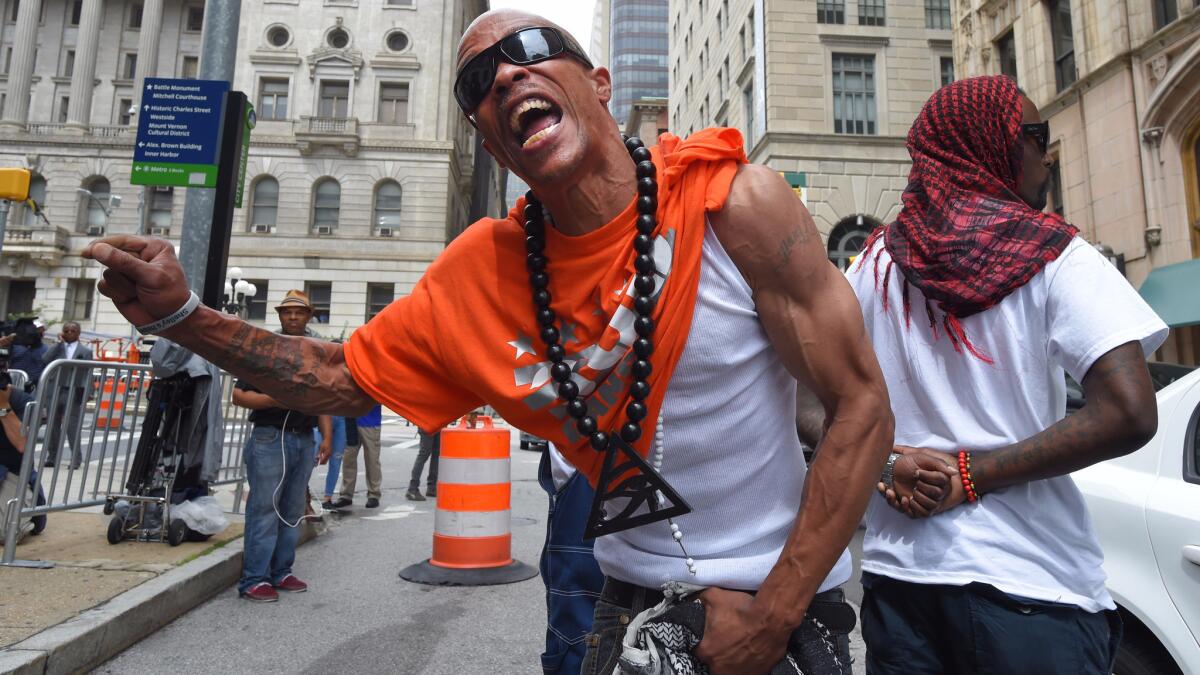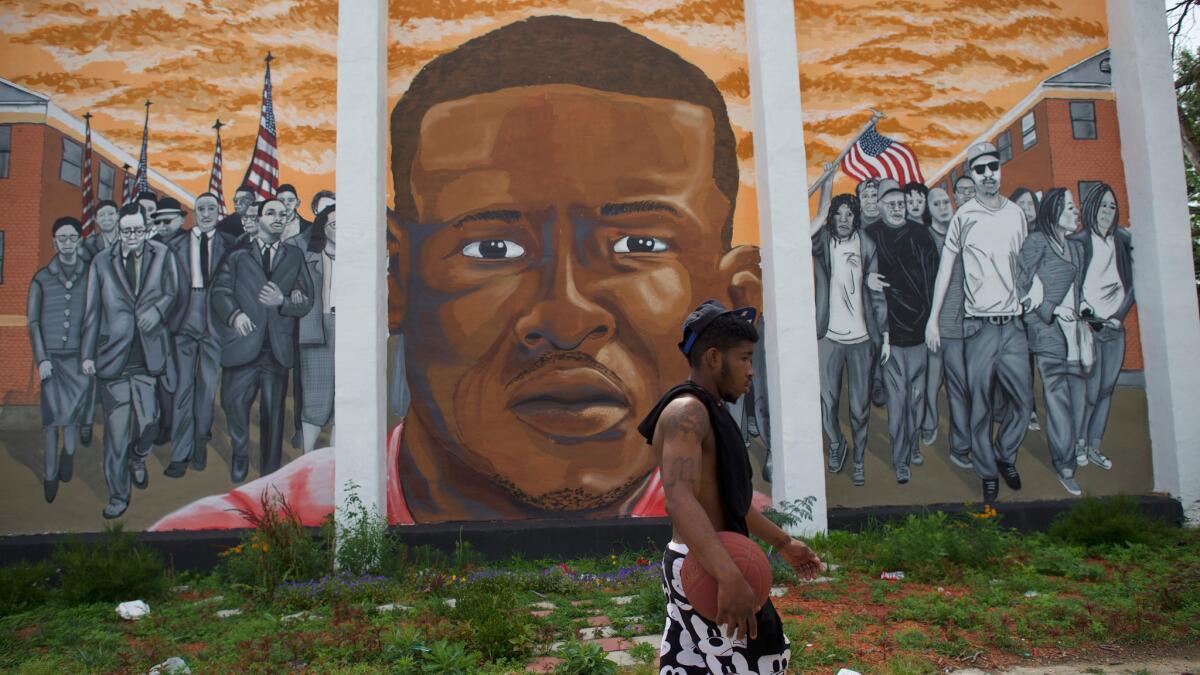Proving ârough rideâ in court is difficult, police and legal experts say

Reporting from BALTIMORE â The criminal cases against Baltimore police officers in Freddie Grayâs death have drawn widespread attention to so-called rough rides, making what had been a little-known practice part of the American lexicon.
But proving a rough ride in court is difficult, according to policing and legal experts.
In the case against Officer Caesar Goodson Jr., the police driver who transported Gray, Circuit Judge Barry G. Williams dismissed the âcenterpieceâ accusation of the prosecution â that Goodson was criminally responsible for Grayâs fatal injuries because he drove in a way that tossed a cuffed and shackled Gray around the van.
âThe term ârough rideâ is an inflammatory term of art first requiring definition and then observable evidence that it occurred,â Williams said Thursday. âThe court finds that there is insufficient evidence that the defendant gave or intended to give Mr. Gray a ârough ride.ââ
NEWSLETTER: Get the dayâs top headlines from Times Editor Davan Maharaj »
Goodson, 46, was acquitted of all criminal charges in Grayâs death. Gray, a 25-year-old black man, suffered a severe spinal cord injury in police custody in April 2015 and died a week later.
Police are rarely charged with crimes when suspects die or are injured in their custody.
Civil cases alleging negligence, which require a lower burden of proof, are more common. Several people or their survivors have won civil lawsuits alleging that they or their relatives were paralyzed or seriously injured after emerging from police transport vans.
Rough rides are an unsanctioned technique in which police vans are driven erratically to cause injury or pain to unbuckled detainees.
In October, the city of Baltimore paid $95,000 to settle a federal lawsuit filed by Christine Abbott, a Johns Hopkins University librarian, who alleged that she was subjected to a rough ride in 2012. Abbott said police did not buckle her in before âmaniacallyâ driving around after her arrest at a party on charges that were later dropped.

At least five others or their relatives have alleged harm in the back of police vans since 1997, with several winning judgments or settling with police, the Baltimore Sun found in a review of court records. Three were paralyzed by the ride.
One of the most sensational cases involved Dondi Johnson Sr., a 43-year-old plumber arrested in 2005 on suspicion of public urination. He was handcuffed and placed in a transport van in good health. He emerged a quadriplegic. A jury agreed that a violent ride in a police van caused his fractured neck and awarded his family $7.4 million, later reduced to $219,000 because of state caps on such payouts.
Stephen P. Norman, the attorney who represented Abbott, said it is harder to prove criminal intent than to prove that an officerâs action violated an individualâs civil rights in a civil case. Without clear and convincing evidence, it is nearly impossible, Norman said.
âHow do you prove it? You have to have videos,â he said.
Last year after Grayâs death, Norman established a âBaltimore city rough ride class actionâ phone line and website to search for other complaints of such actions. He said two people have come forward but their cases do not fall within the three-year statute of limitations.
Norman said Goodson and the other officers should not have been charged criminally without evidence of criminal intent, but that their actions should be reviewed closely by the Police Department to determine any appropriate discipline.
âIf they make a mistake, they shouldnât be prosecuted,â Norman said. âIf you have clear evidence of them giving them a rough ride, thatâs different.â
Williams said that although Goodsonâs failure to secure Gray with a seat belt âmay have been a mistake, or may have been a bad judgment,â it did not amount to a crime.
âSeemingly, the state wants this court to simply assume that because Mr. Gray was injured, and the defendant failed to seat belt him in after Stop 2, allegedly ran a stop sign, and made a wide right turn, that [Goodson] intentionally gave Mr. Gray a rough ride,â Williams said. âAs the trier of fact, the court cannot simply let things speak for themselves.â
Prosecutors could have done more to try to prove that Goodson subjected Gray to a rough ride, said Douglas Colbert, a professor of law at the University of Maryland Francis King Carey School of Law.
See more of our top stories on Facebook »
He said Goodson should have been aware that his failure to secure Gray in a seat belt could have resulted in serious injuries given past civil settlements, directives from commanders and training on protecting prisoners. But prosecutors failed to present testimony that Goodson knew how easy it would be to hurt a detainee in the back of a van, he said.
âIt doesnât take very much for a person who is in cuffs and shackled and has no means to protect himself to lose balance if heâs standing or to get pushed into a metal wall thatâs only inches away,â Colbert said. âA rough ride can be as limited as taking a turn more sharply or simply not driving with the utmost care.â
Former city police officer Charles Key, who is now a consultant and has testified in two previous rough-ride lawsuits in Baltimore, said police have given detainees rough rides, but the practice is rare.
He praised Williams for sticking to the evidence in dismissing the prosecutionâs allegation.
âIâm sure there have been others,â Key said. âLong story short, itâs damn near impossible to prove.â
Donovan writes for the Baltimore Sun.
ALSO
In the final stretch, how will a divided Supreme Court rule on these big cases?
Supreme Court upholds use of affirmative action at universities
FBI investigators say they have found no evidence that Orlando shooter had gay lovers
More to Read
Sign up for Essential California
The most important California stories and recommendations in your inbox every morning.
You may occasionally receive promotional content from the Los Angeles Times.









